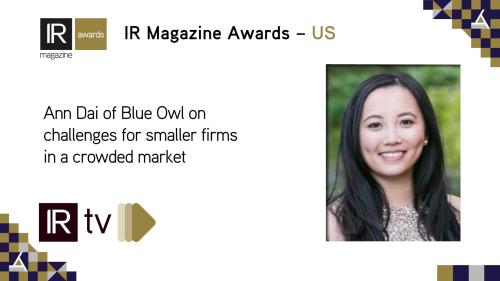Herzogenrath, Germany-headquartered AIXTRON might be a small-cap company specializing in something that sounds – and is – very technical (metalorganic chemical vapor deposition equipment), but the firm supplies technology to clients in the semiconductor industry and is a world leader in its field.
As such, the company has research labs and branch offices in China, the UK, Sweden and the US as well as sales and service offices representing the company in Japan, Korea and Taiwan. It also has the potential to be affected by many of the stories you read about in the news. Here, Guido Pickert, the firm’s head of IR, talks to IR Magazine about how he got into investor relations, how a US executive order cut short a Chinese takeover bid and how he and his team handle short-sellers.
Tell me a bit about how you got into IR, how the team is set up and what you did before joining AIXTRON.
My life before IR was always influenced by communication. During my studies and apprenticeship, I worked for major airlines at Frankfurt Airport practicing my communication skills with passengers from all over the world. Later I worked for a radio station in Frankfurt as part of a young, creative radio crew – further refining my communication skills.
I finished my studies in marketing and international business administration at the time of the Neuer Markt stock market hype in Germany toward the end of the 1990s. And this is when I was offered a role in a newly founded IR agency in Frankfurt – which I took. This opportunity was clearly the perfect job in which I was able to take advantage of my skills and previous experiences combining communications with my understanding of financials.
After seven years of extreme ups and downs in the industry, I took the opportunity in 2007 to join AIXTRON as a one-man team to manage the IR activities of the company. Following another very exciting period of ups and downs, I now oversee a four-strong team: a senior IR manager, a senior PR manager, a CSR manager and a support function.
In 2016 a takeover bid of AIXTRON by China’s Fujian Grand Chip Investment Fund was blocked by then US president Barack Obama. Can you tell us more about that and how it was handled from an IR perspective?
This was a very demanding period in AIXTRON’s history and the most demanding phase of my working life. In 2016 AIXTRON received a takeover bid from a Chinese investor. In preparation for the publication of the offer, all communication and IR measures were thoroughly planned. But what happened after the announcement was unique in its chronology.
We experienced ups and downs during the offer period, during which the German government withdrew its previously issued approval of the merger. This had never happened before, and our small team found itself having to deal with global interest from press and investors.
From an IR point of view, targeted measures to explain the deal rationale in numerous meetings and targeted campaigns led to a 78 percent acceptance rate of the offer. Despite this, the final result was that the offer was ultimately withdrawn following an executive order by the Committee on Foreign Investment in the United States and the US president, blocking the deal.
My major takeaway from this project was that preparation (for everything that can be thought of) is king. Any unforeseen events have to be dealt with quickly and in a pragmatic way, as time becomes extremely rare.
I’ve heard you comment that, at one point, AIXTRON was Europe’s ‘most-shorted company’. How did that come about and how did you handle that from an IR perspective? What is your advice for dealing with short-sellers?
This is, to a large degree, the result of very volatile performance in our shares – driven by volatile market and sector development. Usually in boom times, short-sellers bet on a downturn, which often results in high short quotas. We address some of the short-players that have a clear thesis for their position (versus technical short positions based on instruments in the market) by direct communication with them.
We see no reason to condemn these market participants. Instead, we would rather accept the challenge and face the direct communication as an opportunity to point out the opportunities available – and hope to convince short-sellers to abandon their position in this way.
For a small-cap company, AIXTRON has a healthy analyst following. Why is this?
We are in the very fortunate situation that AIXTRON shares are very popular with investors, which therefore motivates broker houses to cover the stock in order to satisfy the information requirements by their customers.
Do you actively target new investors? If so, how?
Not yet. We still rely on our investor network and the network of our brokers. We are currently in the process of implementing more of our own investor intelligence, however, in order to be able to either challenge and supplement the investor meeting proposals or actively target new potential investors on our own.
What changes have you made to your IR program (if any) as a result of Mifid II? What changes do you expect to need to make in the future?
We believe active investor targeting capabilities as well as CRM and planning tools are key to manage and sustain investor attention now and in the future.
What has been your biggest challenge in IR so far?
To motivate management– and ourselves – to face the mostly unhappy investors during lengthy downturn periods. Investor trust is best built in periods when times are tough rather than in sunny periods when IR communication is supposedly more fun.
What has been your IR highlight?
Having been recognized and awarded a number of times over the years for best IR practice during times of share price underperformance. This is the result of constant and open communication – even during the bad times. For example, in 2011 we saw a circa 30 percent drop in the share price from the year’s peak.
What are some of the top issues investors and analysts are asking about at the moment?
They regularly want to know more about the current trade tensions affecting the tech sector in general and AIXTRON in particular. After that, investors want to understand which existing and future end-market applications are enabled by AIXTRON technologies. Those investors with an investment focus on sustainability also want to know how AIXTRON technologies help to reduce environmental impacts in different areas.
If resources were no object what would you like to do better or more of?
I would definitely do more strategic IR work, such as active investor targeting and more intelligent relationship management as well as a more intensive combination of market and capital markets intelligence. In addition, I would broaden our active communication, such as through social media, and I would offer more intense internal and external educational work.
Finally, what would you be doing if you didn’t work in IR?
Given my profound understanding of technology and my private interests, I guess I would be in media, automotive or tech marketing.










